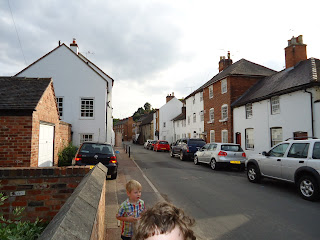 |
| Birdswood at the Wharf |
A conversation on radio Derby with Andy Potter ended with
him asking ‘What’s your next project?’
Thinking off the cuff I said ‘The A6 has some nice views! I
may paint that!’
At the time I had no plans as to what I was going to do next
having just finished 40 Ripley rattler paintings for DH Lawrence museum I quite
fancied not doing much at all.
But then at the end of my street I noticed a big Protect
Belper sign draped across two houses a protest about new builds on land within
the World heritage zone.
I went to look at said field and took a photo this led me to
wonder what happens next in Belper and indeed the corridor that is the world
heritage site along the Derwent Valley.
Which led me to wonder why world heritage what’s that all
about?
Completely new to the area in a way although a lifelong
visitor Id not given much thought to the tea rooms and pleasant canal sides and
views of mills it’s all kind of a pretty back drop to spend a weekend I’d been
a tourist. Indeed, my sons school Long Row I chose for its aesthetic appeal!
So I decided to do some research and look into the past and
present use of the Derwent Valley. I attended some Discovery day events in
Belper nosed around some houses in Long Row and some Chevin View back to backs
my sons had a go at mangles in the wash day exhibit.
I went to a talk by Adrian Farmer and bought his book
looking at the then and now photos. I went to the library and in the local
history section I discovered another artist in the 80s had painted the whole of
the Derwent from lady Bower to the Trent junction a fantastic book.
I wanted to approach my paintings from a different
perspective rather than pick the prettiest views I wanted a comprehensive
collection of work showing the breadth of activity that has taken place in this
small valley.
The choice of what to paint and how many was quite logical I
had room for about twenty paintings, so using another book Id bought I looked
at the valley as a whole and tried to divide it up to include firstly all the
mills, then the housing and finally the vistas showing the setting.
All of them are painted on box canvas in acrylic for a
unified look and each was created in the studio but the two below were started as a demo
in front of an art group.
All are from photographs so getting some of the images has
resulted in some twitching of net curtains wondering what the crazy art lady is
doing photographing their street.
Before each painting there had to be a day trip planned or
lucky for me the school run provided many chances to get the correct light effect
needed for Long Row and The East Mill.
My children have unwittingly been walked and educated along
canal sides stumbling upon aqueduct cottage which is devastingly beautiful as a
ruin but hopefully will be restored.
Ice cream promises got them into the silk mill where they
were fascinated by the rolls Royce engine and land line telephones with dials!
A walk along a wet path with a slight naughty deviation to
get the view of Peckwash mill resulted in youngest son falling flat on his face
in mud and the resulting car journey was smelly and traumatic but I got my
image!
There have been good days for my kids Christmas trips to Gulliver’s
Kingdom and birthday treats to Heights of Abraham resulting in great vistas.
What I discovered was the rate of building work undertaken
throughout the Industrial revolution Arkwright and Strutts changing the way we
work and live at a monumental pace. The river powering the changes canals
bringing in and out the goods the coming of the railway cutting through Belper
in a spectacular fashion, paper mills, silk mills, textile mills and workers
dwellings that have been copied around the world.
But time moves on the Industrial Revolution has long since
been replaced by the technological and digital advances of our age and it no
longer makes sense to be manufacturing alongside a steep sided river far better
to use cheap labour from overseas and create mega warehouses alongside the new
Motorways.
So what have we left? A landscape scared with what we see
today canal architecture, huge factories, pump houses, with their respective
workers housing and boss’s mansions.
It may be scared by its past but it’s beautiful my journey
from the protect Belper sign to now has led me to conclude that it must be
protected for everyone it is an outstanding and unique place a preserved time capsule
but one that is ever evolving and its great to see the buildings open and being
used for new industries and leisure.














No comments:
Post a Comment